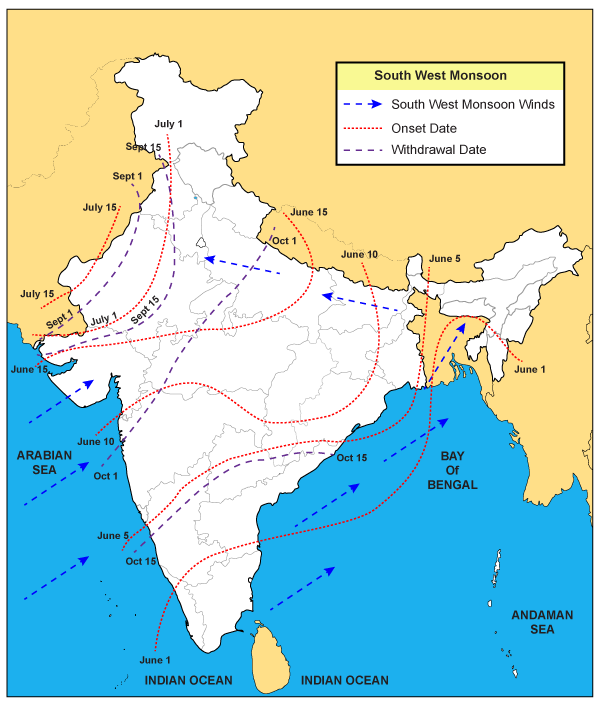Note4Students
From UPSC perspective, the following things are important :
Prelims level: Monsoon: Its onset and retreat
Mains level: Various factors causing uncertainty in monsoon predictions

The India Meteorological Department (IMD) had decided to revise the normal onset and withdrawal dates for the monsoon in some parts of the country from this year.
Onset of Monsoon
- The four-month southwest monsoon season, which brings as much as 70 per cent of the country’s annual rainfall, officially begins on June 1, with the onset over Kerala, and ends on September 30.
- It takes about a month and half after onset on the Kerala coast to cover the entire country; and about a month, beginning from the northwestern parts of the country on Sept. 1 to withdraw completely.
- Although the June 1 date for the onset of the monsoon on the Kerala coast is unlikely to be changed, the dates for onset in many other parts of the country are expected to be revised.
- Mumbai, for example, expects to start getting rain from June 10 the revision is likely to push this date back by a few days.
- Effectively, the monsoon is now expected to have later arrival and withdrawal dates in most parts of the country.
Why was this revision needed?
- The main reason for the revision in the normal dates is the changes in precipitation patterns that have been taking place over the last many years.
- In the last 13 years, for example, only once has the onset over the Kerala coast happened on June 1.
- While two or three days of earlier or later onset falls within the yearly variability in several years the onset happened five to seven days late.
- Similarly, the commencement of withdrawal has happened in the first week of September only twice during this period, and last year, the withdrawal started as late as October 9 — and was completed in around just a week.
Recent peculiarity with the exam
- One of the significant changes being noticed is that rainfall is getting increasingly concentrated within a narrow band of days within the monsoon season.
- So, there are extremely wet days followed by prolonged periods of dry days.
- IMD data show that over several previous years, nearly 95 per cent of monsoon precipitation in 22 major cities of the country had happened over a period of just three to 27 days.
- Delhi, for example, had received almost 95 per cent of its monsoon rainfall over just 99 hours. And half of Mumbai’s monsoon rain had fallen over just 134 hours, or five and a half days, on average.
Regional variations
- Patterns of regional variations in rainfall are also changing
- Areas that have traditionally received plenty of rainfall are often remaining dry, while places that are not expected to get a lot of monsoon rain have sometimes been getting flooded.
- Climate change could be one of the factors driving these changes, but there could be other reasons as well.
What will be the impact of IMD’s move?
For Farmers
- The revisions are meant to reflect the changes in precipitation patterns in recent years.
- New dates will likely nudge farmers in some parts of the country to make slight adjustments in the time of sowing their crops.
- It would definitely have an impact on our agriculture practices — when to start sowing, when to harvest.
- So, even if there is a delay in the arrival of monsoon by three to four days over a region, it would not matter much if there is a fairly good rainfall distribution thereafter.
- The change in dates would affect water management practices as well.
For Industries
- The planning that goes to beat the heat — several cities execute heat action plans — just ahead of the monsoon would have to factor in the need to be prepared for longer periods of heat.
- Rajeevan said many other activities including industrial operations, the power sector, or those using cooling systems, would also need to change their behaviour.
- The power grid can, for example, have more realistic planning for peak periods of electricity consumption in certain months.
Way Forward
- The changed dates are expected to be announced in April, when the IMD makes its first forecast for the monsoon.
- Agro-meteorologists, however, agree that more than the onset, it is the information about the spatio-temporal distribution of rainfall that will be more helpful for farmers.
- Ultimately, the change in normal dates of the onset and withdrawal of the monsoon would help people understand when to expect rains, and to plan their activities accordingly.
Get an IAS/IPS ranker as your 1: 1 personal mentor for UPSC 2024
